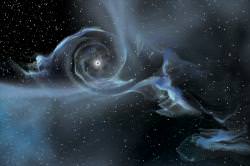Wait, stop the internet! Remember when I said the most massive black hole had been discovered? Sorry, that record has been broken by an even more “most massive black hole”. 16 times the mass of the Sun? Please. This new one raises the bar with a mass of 24 to 33 times the mass of our Sun.
As with the previous black hole, located in the nearby galaxy M33, this newly announced black hole is in a binary system. It’s located in the nearby dwarf galaxy IC 10, 1.8 million light-years from Earth in the constellation Cassiopeia. Since it’s orbiting another star, astronomers were able to calculate its mass – 24-33 solar masses.
The discovering team, led by Andrea Prestwich of the Harvard-Smithsonian Center for Astrophysics used NASA’s Chandra X-ray Observatory to study IC 10. They observed that the galaxy’s brightest X-ray source, IC 10 X-1, varied in brightness. This led them to believe that a star was periodically passing in front of a black hole, briefly obscuring it from view.
Follow up observations with NASA’s Swift satellite confirmed that the black hole was being eclipsed by the companion star, and gathered enough data that astronomers could work out the orbital period, and thus the masses of both objects.
A black hole this massive is surprising. Astronomers calculate that massive stars should throw off most of their gas before detonating as supernovae. No black hole should be able to exceed 15 times the mass of the Sun.
In the case of IC 10 X-1; however, it’s blown past that theoretical limit. Of course, it could have detonated as its largest size, and then consumed material from its companion article. But according to their calculations, it could only have gained 1 or 2 solar masses over the years.
So how did it get so large?
It probably started life with about 60 times the mass of the Sun. Since its host galaxy is deficient in any heavier elements, it was probably composed largely of hydrogen and helium. The heavier elements are actually easier to blow away from the star on the solar wind, so it maintained most of its mass right up until the end.
Original Source: CfA News Release


the previous article on this site talked about black holes with mass millions of times that of the sun. How is this discrepancy explained. Are those stars that much larger.
why can a black hole only get so big? or take in all of the matter around it?
sorry that should say, “and “can’t” take in all of the matter around it?”